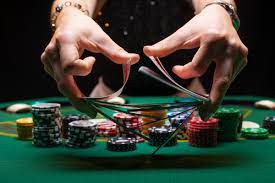Slot machines, the iconic symbols of topbandar worldwide, have an irresistible allure that transcends generations. From the clinking sounds of coins to the flashing lights and thrilling anticipation, slot machines offer an unparalleled entertainment experience. However, behind their glitzy facade lies a fascinating world of mathematics, psychology, and technology. In this article, we delve deep into the mechanics, history, and psychology of slot machines, uncovering the secrets behind their enduring popularity.
The History of Slot Machines:
The origins of slot machines can be traced back to the late 19th century when a mechanic named Charles Fey invented the first mechanical slot machine, known as the “Liberty Bell,” in 1895. Featuring three spinning reels adorned with symbols like horseshoes, diamonds, spades, hearts, and a cracked Liberty Bell, Fey’s invention laid the foundation for modern-day slots.
Over the years, slot machines evolved from mechanical contraptions to electromechanical marvels and eventually to the digital video slots we see today. The introduction of microprocessors in the 1980s revolutionized the industry, allowing for more complex game mechanics, advanced graphics, and interactive features.
How Slot Machines Work:
At the heart of every slot machine is a random number generator (RNG), a computer program that generates thousands of random numbers per second. These numbers correspond to the position of the symbols on the reels, determining the outcome of each spin.
Contrary to popular belief, slot machines do not have “hot” or “cold” streaks. Each spin is independent and unrelated to the previous or subsequent spins. This concept, known as “randomness,” ensures fair gameplay and prevents any predictable patterns or strategies.
Paylines, Symbols, and Payouts:
Modern slot machines come in various formats, from classic three-reel slots to elaborate video slots with multiple paylines, bonus rounds, and special features. Each slot game has its unique theme, symbols, and paytable outlining the payouts for different combinations.
Paylines are the paths across the reels where matching symbols must land to form winning combinations. Traditional slots typically have one to three paylines, while video slots can have dozens or even hundreds of paylines, increasing the chances of winning.
Symbols range from classic fruit icons like cherries and lemons to thematic symbols like animals, treasures, and characters. Wild symbols substitute for other symbols to form winning combinations, while scatter symbols often trigger bonus features like free spins or mini-games.
The Psychology of Slot Machines:
Slot machines are meticulously designed to captivate players and keep them engaged for extended periods. Everything from the game’s theme and graphics to the sound effects and animations is carefully crafted to create a immersive experience.
The concept of “near misses” plays a significant role in the psychology of slot machines. Near misses occur when two or more matching symbols land on the reels, tantalizingly close to a winning combination. These near misses trigger a dopamine release in the brain, creating a sense of anticipation and encouraging players to continue spinning in hopes of hitting the jackpot.
Conclusion:
Slot machines have come a long way since their humble beginnings, evolving into sophisticated gaming devices that blend cutting-edge technology with captivating gameplay. Whether you’re a casual player or a seasoned gambler, the allure of slot machines remains as strong as ever, offering endless excitement and the chance to win big. So the next time you step into a casino or log into an online gaming platform, take a moment to appreciate the ingenuity and complexity behind these mesmerizing machines.




